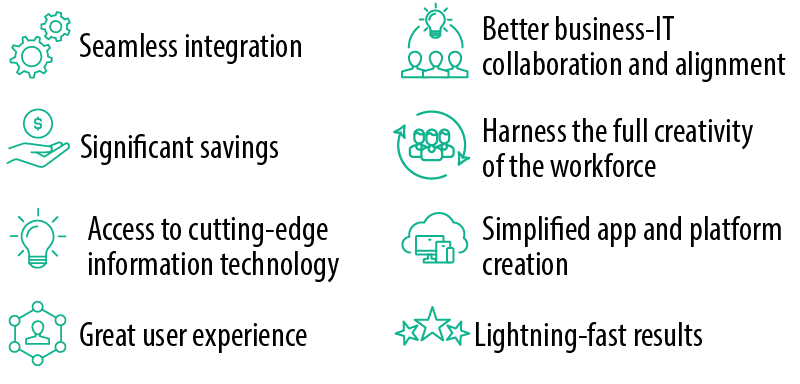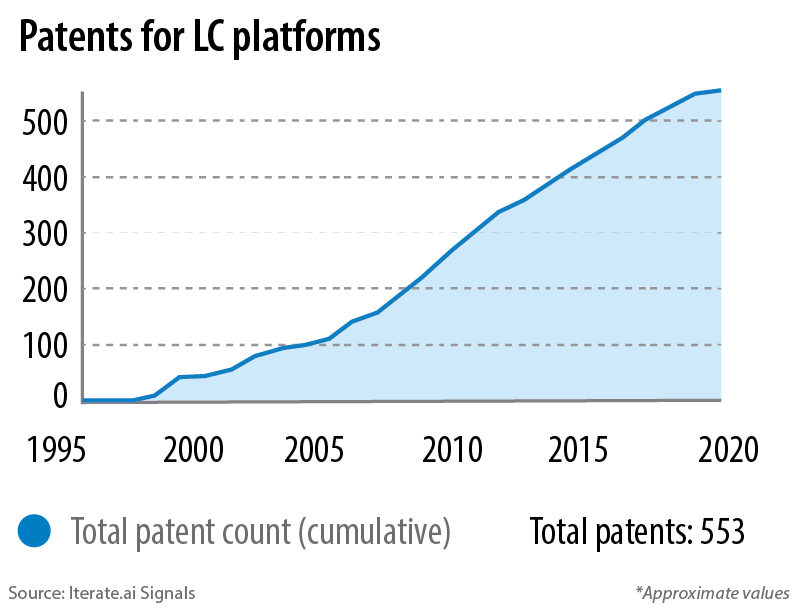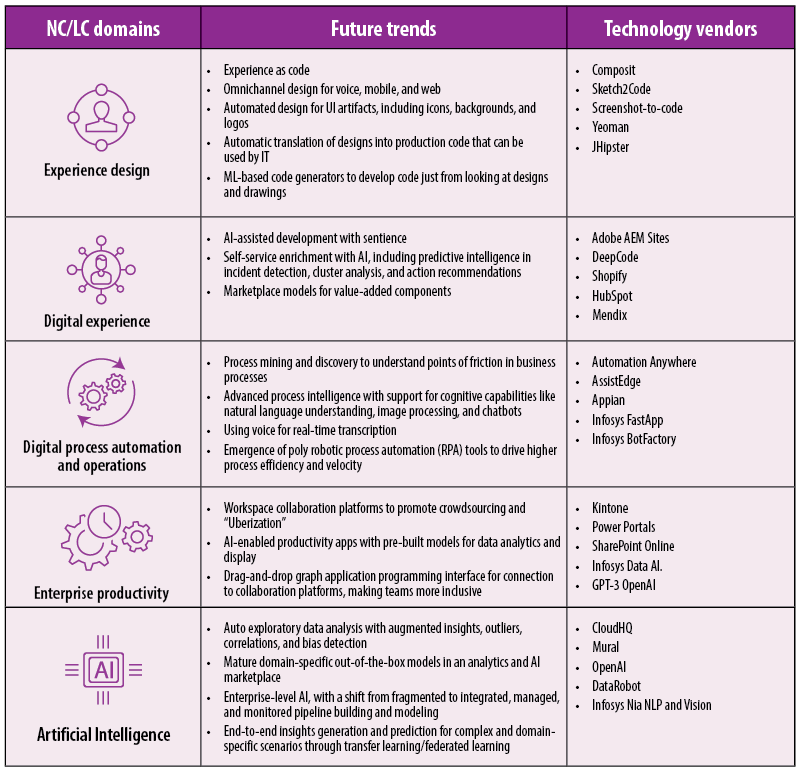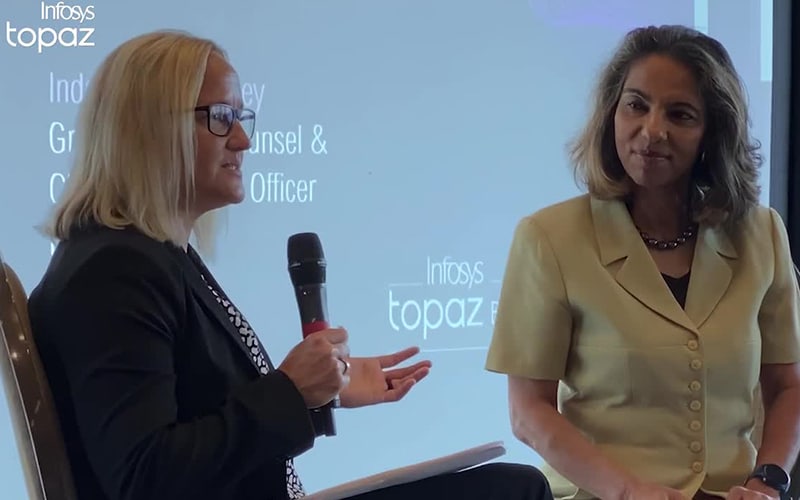Insights
- No code/low code (NC/LC) technologies help develop software programs with little to no hand coding, providing a boon to enterprise productivity.
- With point-and-click or pull-down menu interfaces, everyone from token wizard developers to sales personnel can easily develop and implement individual or departmental systems.
- NC/LC offers seamless integration, better business-IT collaboration and alignment, significant savings, and a great user experience.
- Future trends include experience as code (experience design); AI-assisted development with sentience (digital experience); voice for real-time transcription (digital process automation); workspace collaboration platforms (enterprise productivity); and auto exploratory data analysis (artificial intelligence).
- Using NC/LC, firms can develop products and services that are tightly woven to market dynamics and customer appetite.
The holy grail in digital are those employees that understand the business as well as technology. Those that bridge the gap between the two sides are highly sought after but hard to find.
But what if you could turn all of your employees into technologists, giving them the power to apply their business knowledge while they develop the software to support their business function?
No code/low code (NC/LC) technologies help develop software programs with little to no hand coding. With point-and-click or pull-down menu interfaces, everyone from token wizard developers to sales personnel can easily develop and implement individual or departmental systems. The technology simplifies app creation workflows and analyzes real-time data using pre-built artificial intelligence (AI) engines. These solutions are more human centric, with flexible applications built by diverse teams that factor in the unique requirements, frustrations, and concerns of customers and employees.
A good example of such a technology is Canva, the multimedia design platform. Users create visual content at low cost with heightened control over the look and feel of the experiences created. Agile teams of coders and designers can work together effectively: The designers can spend their time mocking up stylistic designs, and the coders can concentrate on the logic in an 80/20 effort split. The real magic of these tools, including old-school players like Adobe (with their XD suite), is that the underlying layers of software are integrated into end products, leaving teams to focus on the user interface.
There are also cost- and time-efficient platforms, like upBoard, that are building marketplaces of instantly customizable business process apps. SAP Fiori, Salesforce Lightning, and MS Dynamic are examples of platform players stretching into the market. These business platform add-ons give “citizen developers” the ability to customize enterprise applications, extend application functionality, and provide mobility extension on business platforms. The Infosys Bot Factory is a marketplace of LC value-added components and artifacts numbering in the thousands. Firms use the technology to design conversation workflows at speed, improve the customer experience, and increase sales and retention.
NC/LC solutions are human centric and employ diverse teams that factor in the unique requirements and concerns of customers and employees
In all, NC/LC technologies save time, reduce IT efforts, cut costs, solve technological challenges, improve agility, increase productivity, and much more (see Figure 1).
Figure 1. NC/LC benefits

Source: Infosys
Differences between NC and LC
The desire for NC/LC tools — ranging from Microsoft’s PowerApps technology to JHipster and Yeoman (both automatic code generators) — is intensifying across enterprises. The market for these technologies is estimated to grow from $17.7 billion in 2021 to over $125 billion by 2027.\ 1
Both LC and NC technologies ease application development because of minimal coding requirements. However, the two approaches differ in scale and type of applications
NC platforms are designed for business professionals. They require less than 5% of the coding to be done manually and are mostly cloud- and subscription-based. Typical uses range from simple reporting to applications that evolve with frequent updates. Players in this space include Figma and Adobe XD (experience design), Unqork and Zudy (digital experience and application), and Amazon Honeycode (enterprise productivity). Small and midsized businesses use trial and error to deploy these tools in use cases with great growth potential. Quick wins with NC include sales funnel optimization and churn reduction.
In contrast, LC environments are slightly more complex and are designed for enterprise users. They usually require up to 20% hand coding. The LC process is akin to an assembly line that strings together Lego-like pre-wrapped code modules built around business services. The resulting applications can utilize API-based solutions offered by other companies (think payment processing or social integration).
LC platforms can reduce application development time by as much as 90%.2 In a survey carried out in the engineering space, 85% of respondents said that LC would be commonplace within their firms by this year.3 The number of patents for LC platforms has significantly spiked in the past years (see Figure 2).
Figure 2. Rising patents for LC platforms

Case study: Boeing used Infosys Nia AML LC technologies to forecast demand for materials in their supply chain. The solution used an automated analytics procedure that leveraged multiple ML and statistical techniques to optimize the algorithm.
Effective upskilling and governance needed
The implementation of these technologies — whether NC/LC or business platform add-ons — is not easy. Hardwiring new custom applications to complex CRM and ERP platforms can be costly. Shadow IT prevails when the whole organization uses the power of cloud, data, and AI. And some systems just don’t work well with legacy architecture. Even though these platforms are easy to build, they still require experienced coders for smooth functioning. Data privacy experts are also needed to ensure that the self-service approach to data ingestion doesn’t fall foul of regulations or create potential openings for advanced cyberthreats. Also, the whole organization requires upskilling and community development to work in a more Agile, open operating model.
With the right governance and monitoring services, firms can develop better internal and external business experiences and unleash exponential technologies. With an effective NC/LC playbook, business leaders can ensure their teams are using the technology appropriately. This means having the right policies in place, along with guidelines around which applications are allowed to be built on a platform and by whom. It also means designating a central authority to own the approval process.4 Also, the whole enterprise should know which business processes can be automated using these tools and where manual, or “human in the loop,” exceptions are necessary.
The future of NC/LC
When deciding an NC/LC use case, firms should consider the following five key domains: experience design, digital experience, digital process automation and operations, enterprise productivity, and AI (see Table 1).
Table 1. The future of NC/LC across five domains

Source: Infosys
Use cases of advanced NC/LC
Vodafone UK is using advanced NC tools to improve the digital experience. Its need for rapid customer service delivery has grown as the number of channels and types of service requests customers can use and make has expanded. With on-demand portals and digital technologies, like Amazon Alexa, customers expect an omnichannel experience. To deliver new capabilities more quickly and adapt to technologies coming out every quarter, the company’s senior leadership envisioned a platform that empowers the business to self-serve with minimal IT support. Agile was chosen as the methodology, bringing together disparate business units into self-contained autonomous teams. They chose an NC tool with AI that enabled issue predictions, customer cluster analysis, and predictive intelligence (or next-best recommendations).
The result was a guided assurance program for their broadband customer service group that provided a structured process for service representatives to solve customer pain points quickly. The minimum viable product was ready in four months, and the final product went live in just two weeks. The program could reduce average handling time for cases by 10% and first-call resolution time by 5%. The enterprise saw an 18% increase in its net promoter score.5
With NC, complex analytical constructs can be visually modeled, simplifying the incorporation of semi-structured and unstructured data
Some robotic/digital process automation tools aid the discovery of automation opportunities. For instance, the cloud-based Infosys FastApp tool connects to AI services such as vision, speech, language, and document interpretation to create augmented automation. It enables users to import business process modeling notation and shortens onboarding duration. Other use cases include vision services to securely scan and validate ID documents, decision services for real-time underwriting decisions, automated routine data-update screens from third-party registries using cloud RPA, and a collaborative end-to-end process through a process management engine.6
Using the solution, Infosys helped BP’s global oil segment to streamline its IT operations by “botifying” over 200 processes. For another client, Infosys built more than 300 processes in only 10 months through Infosys IP and FastApp.7
Other companies as diverse as HubSpot, Starbucks, and WestCap are leading the way across all five domains. According to Gartner, 41% of businesses now have active “citizen development” initiatives at the forefront of AI and data science, with 20% of the businesses that don’t either evaluating them or planning to start them.8
Alan Trefler, the founder and CEO of Pegasystems, also sees value in bringing NC/LC capabilities together across domains. This enables Agile teams to collaborate and construct advanced applications in real time. With NC workspace collaboration platforms and auto exploratory data analysis (see Table 1), even complex analytical constructs can be visually modeled, simplifying the incorporation of semi-structured and unstructured data. This means “projects that once took dozens of programmers, months of time, and tens of thousands (if not millions) of dollars, may now only take days, weeks, or months, with internal staff.”9
The human-centered workforce
Power comes with simplicity, speed, and co-collaboration. Using NC/LC, firms can develop products and services that are tightly woven to market dynamics and customer appetite. Instead of changing legacy systems, these firms can establish a two-speed mode of application development. As firms shift gear into designing simple, modular software components, they can unbundle and rebundle core competencies and create leaner and consumer-oriented organizational structures — a strategy that our Agile Radar 2021 research shows increases business outcomes substantially.10 The technology can also fetch greater profits, as our Digital Radar 2022 research has proved.11
Knowledge work will become more rewarding by opening doors to the wider ecosystem (and economy). With routine, mundane tasks largely automated, organizations will be able to free their employees to create better stuff for the big Ps of the triple bottom line — People, Planet, and Profit.
References
- Low code/no code increases efficiency in retail and beyond, Kyle Wiggers, Oct. 13, 2021, VentureBeat
- Ibid
- How low-code development helps companies increase productivity, Cecilia Santis, May 12, 2020, Pillir
- 5 key governance principles for low-code success, May 28, 2021, Forbes
- How citizen developers are improving the customer experience, Ken Benner, July 9, 2018, Pega
- Digital process automation, 2021, Infosys TechCompass
- Ibid
- See Ref 1
- See Ref 5
- Agile Radar 2021, IKI
- Digital Radar 2022, Jeff Kavanaugh & Chad Watt & Isaac LaBauve, IKI





